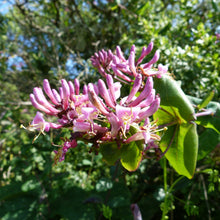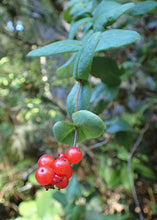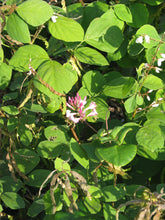Lonicera hispidula
Hairy or pink honeysuckle is one of our region’s few native vines, which features lightly-perfumed, tubular pink to purple flowers with prominent golden stamens that are highly attractive to hummingbirds and other pollinators. Similar to its orange-flowering cousin, this species is relatively easy to grow, with twining branches that sprawl loosely along the ground or climb with the support of a trellis, creating excellent nesting areas for small birds. True to its name, the foliage is often hairy and glandular and is believed to be a larval food source for dozens of species of butterflies and moths. After its blooms fade, pollinated flowers become clusters of bright red fall berries that are attractive to backyard birds.
- Plant type/canopy layer: deciduous, perennial, sprawling vine/small shrub
- Size at maturity: vine can grow up to 20’ long
- Light requirements: part sun/part shade ideally, but will tolerate mostly sunny to mostly shady locations
- Moisture requirements: moist to dry soil
- Bloom time: May - August
- Growth rate/ease: fast growing, relatively easy to grow
- Wildlife support: flowers attract and provide nectar for hummingbirds, adult butterflies, bees and other insect pollinators; berries are eaten by juncos, waxwings, finches, robins, grouse, pheasants, flickers, thrushes, bluebirds, and grosbeaks; branches makes great nesting sites for small birds; overall plant attracts and supports beneficial insects and pest-eating insects and is a caterpillar host and larval food source for up to 25 species of native butterflies and moths including the Geranium Plume Moth, the Variable Checkerspot moth and the White-lined Sphinx moth.
- Native habitat/range: relatively common growing on moist to dry sites in open mixed woods, clearings, slopes and streambanks, from low to mid-elevations, west of the Cascade crest (except in a few of the moistest, coastal counties) throughout British Columbia, Washington and Oregon and in the Sierras and coastal mountains of California. Portland Plant List - yes.
- Special features & uses: wildlife favorite; deer resistant; ethnobotanical uses include hollow stems as pipe necks and the burned wood ashes for tattooing; landscape uses include pollinator gardens, rock gardens, open woodland gardens, bank stabilization, erosion control and habitat hedgerows
Gardening with Hairy Honeysuckle: It’s easy to find a place for this versatile, showy species in any habitat garden. It tolerates a wide range of conditions, from full sun to full shade, and soils that are moist to dry with any drainage, including clay. This versatility makes it an excellent choice for tough slopes where stabilization and erosion control is a goal, or as a striking addition to a trellis or other structure. That said, its ultimate preference is for partial sunshine, with acidic, well-drained soils that are moist for most of the year and dry in the summer, with minimal irrigation. Though the flowers are gorgeous, do not expect this plant to be as showy as the countless varieties of honeysuckle that have been bred exclusively for beauty (as opposed to being a dynamic, multi-faceted member of its native ecosystem) by the horticultural industry. Like most natives, plan to interplant this with complimentary species that can share the stage rather than expecting it to perform a season-long solo. A few ideas include snowberry, oceanspray and salal in the shrub layer and herbaceous plants like lady fern, candyflower, fringecup and much more.
Photo Credit 1: "Pink Honeysuckle (Lonicera hispidula)" by StephanieFalzone is licensed under CC BY 2.0.
Photo Credit 2: "Lonicera hispidula kz03" by Krzysztof Ziarnek, Kenraiz is licensed under CC BY-SA 4.0.
Photo Credit 3: "Lonicera hispidula" by peganum is licensed under CC BY-SA 2.0.






